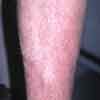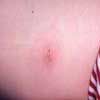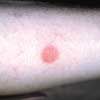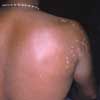Asteatotic Eczema and Herpes Simplex
or several years, a 71-year-old man has had a pruritic eruption on both legs that occurs every winter and resolves in the spring. He is scheduled to undergo knee surgery, but the surgeon will not perform the operation until the rash has cleared. The patient has not used a new soap or changed his bathing habits recently.

Case 1:
For several years, a 71-year-old man has had a pruritic eruption on both legs that occurs every winter and resolves in the spring. He is scheduled to undergo knee surgery, but the surgeon will not perform the operation until the rash has cleared. The patient has not used a new soap or changed his bathing habits recently.
What do you suspect?
A. Contact dermatitis to soap.
B. Asteatotic eczema.
C. Psoriasis.
D. Stasis dermatitis.
E. Ichthyosis.

Case 1: Asteatotic eczema
This patient had asteatotic eczema, B, which developed during the winter because of ambient dryness and the decrease in sebum production that occurs with aging. Changes in his bathing habits (shorter, cooler baths), regular application of moisturizer, and treatment with a mid-potent topical corticosteroid brought the condition into remission, and the patient was able to undergo knee surgery.

Case 2:
A 41-year-old woman presents with a tender rash of sudden onset on her right anterior thigh. She has never had a similar rash and has no recent history of trauma or insect bite. For 3 years, the patient has had recurrent genital herpes that she treats episodically with oral antiviral therapy; she is otherwise healthy.
What is your clinical impression?
A.Impetigo.
B.Contact dermatitis.
C.Brown recluse spider bite.
D.Herpes simplex.
E.Irritant dermatitis from shaving.

Case 2: Herpes simplex
A culture confirmed the clinical impression of herpes simplex type 2, D; the lesion was within the dermatome of the original vaginal inoculation. The patient was treated with an oral antiviral agent and had an uneventful recovery.
Because impetigo can mimic herpes simplex, cultures are helpful in distinguishing these 2 infections. Contact dermatitis is typically pruritic rather than tender. Brown recluse spider bites appear more ischemic than this patient's lesion. Irritant dermatitis would not produce the vesicles seen here.

Case 3:
A 39-year-old woman, who is being treated for a urinary tract infection, is concerned about a red, slightly tender spot on her forearm. She recalls having had a similar lesion several years earlier. The patient has 2 cats.
What do you suspect?
A. Superficial basal cell carcinoma.
B. Nummular eczema.
C. Fixed drug eruption.
D. Tinea corporis.
E. Contact dermatitis.
What course of action do you pursue?
F. Ask the patient about the medications she is taking.
G. Perform a skin biopsy.
H. Question the patient about the previous similar eruption.
I. Prescribe an antifungal cream.
J. Switch to another antibiotic for the urinary tract infection.

Case 3: Fixed drug eruption
Further questioning revealed that the patient was taking a sulfa antibiotic, F, for the urinary tract infection. She also remembered that the previous eruption had occurred after she had been given a sulfa agent, H. This history supported the diagnosis of a fixed drug eruption, C. This circular, erythematous lesion recurs at the same location after rechallenge with the same drug.
The original antibiotic was discontinued, and a non-sulfa agent was prescribed, J. If the eruption had not cleared, a biopsy to rule out skin cancer may have been appropriate.
The coin shape of this lesion suggested nummular eczema, but its solitary appearance and the absence of pruritus ruled out that disease. Pruritus is characteristic of contact dermatitis and tinea corporis lesions, which are neither transient nor tender.

Case 4:
For 3 to 4 weeks, a 30-year-old man has had asymptomatic light-colored areas on his right shoulder. The patient is an amateur bodybuilder; he is otherwise healthy and takes no medications.
What is the likely cause of these hypopigmented areas?
A. Tinea versicolor.
B. Pityriasis alba.
C. Vitiligo.
D. Psoriasis.
E. Pityriasis rosea.

Case 4: Tinea versicolor
The round and oval hypopigmented, slightly scaly patches on the upper body strongly suggested tinea versicolor, A, which was confirmed by a potassium hydroxide evaluation. The reason for the unilateral distribution of the eruption was not determined. The heat and sweating generated by bodybuilding exercises may have predisposed the patient to this infection.
Pityriasis alba has indistinct borders and most frequently affects patients with atopy. Psoriasis and pityriasis rosea feature more scale and are more pruritic. Scale is absent in vitiligo, which is in the differential.